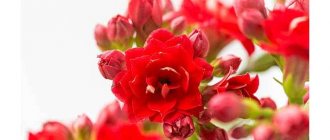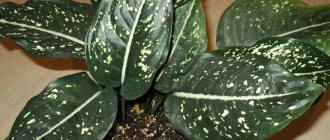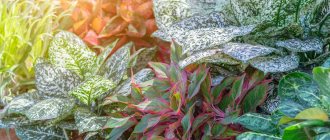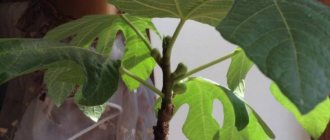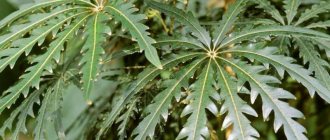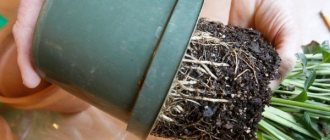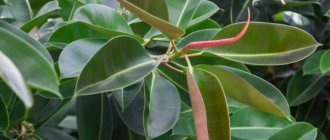2. Propagation of indoor plants
Throughout its life, the plant produces lateral shoots and basal suckers , which are used for vegetative propagation in spring or summer.
- Cuttings of aglaonema are best done in a special heated container, in vermiculite.
- Often cuttings take root even in a simple glass of water. You can even plant stems that have taken root and do not have leaves - they will begin to grow from the awakened lateral buds and will produce additional shoots from the buds that are located underground.
- Such stem cuttings should be placed horizontally, lightly sprinkled with moist soil - this will make the plant more lush, because leaves and roots will appear in each dormant bud.
- The successful completion of the rooting process will be indicated by the appearance of signs of new growth - young shoots.
Many varieties of Aglaonema are propagated by seeds and air layering . Seeds germinate in 25 - 30 days. For propagation, only freshly collected seeds are used.
Large adult specimens are propagated by division , which is carried out in the spring, during transplantation. The bushes are divided in such a way that each part ultimately receives its own, well-developed root system and green ground part.
↑ Up,
4.Aglaonema - home care
4.1.Soil
Well-drained, loose, moisture-permeable soil made from leaf humus, coarse sand, peat, heather soil.
The substrate should have good drainage and easily allow both moisture and air to pass through to the plant's root system.
↑ Up,
4.2.Watering
abundant watering during warm periods. In winter, the frequency of watering is reduced, but without allowing the earthen clod to dry out.
The flower suffers from excessive watering and stagnation of water in the pot.
Drain excess water from the pan within a few minutes after watering.
Water only with warm, soft water; the frequency will depend on the temperature and the degree of illumination.
↑ Up,
4.3.Growing, how to prune
Aglaonema is quite capricious and often does not forgive violations of agricultural practices.
The plant does not tolerate low temperatures well - it curls the tips of the leaves and does not like cold drafts.
During the winter months, plants often develop some yellow leaves at the base.
Tall varieties may require support to grow.
Plants will appreciate periodic bathing in the shower during the warmer months.
It is worth pinching old, yellowed leaves in a timely manner.
To prevent the plant from wasting its energy on forming flowers, the buds immediately removed . Pruning is carried out only with a sharply sharpened and sterile instrument.
In the summer months, you can take the flower out into the fresh air , placing it in a place where it will be protected from direct sun, strong gusts of wind and rain.
4.4.Lighting
Green-leaved varieties are shade-tolerant and suitable for poorly lit rooms; they can get burned when exposed to direct sunlight.
When grown indoors, variegated varieties, especially red ones , need more sunlight than green ones.
If aglaonema lacks sunlight, use artificial illumination with fluorescent lamps.
↑ Up,
4.5. Fertilizer of aglaonema
Flowers in pots have a limited feeding area and need regular feeding .
In the summer, every 2 weeks we feed the aglaonema with flower fertilizers with a minimum amount of lime; We do not feed the plant in winter.
4.6.Temperature
House flowers grow well at room temperature, during the period of intensive growth - 20 - 25 ° C. The minimum temperature in winter is not less than 15°C , although it can briefly withstand a drop of up to 10°C.
The flower comes from tropical latitudes; it does not require a winter dormancy period, although it is welcome.
The plant does not like sudden changes in temperature and intense summer heat (more than 26 ° C).
↑ Up,
4.7.Air humidity
Likes regularly ventilated rooms, however, without cold drafts.
Aglaonema prefers high air humidity and regular spraying with soft water, but it tolerates dry air only for a short time.
A flower pot can be placed in a tray with wet pebbles or sphagnum moss; a room humidifier or a decorative fountain can also be used to increase humidity.
↑ Up,
Top dressing
Caring for the plant involves not only regular watering, but also fertilizing. Mineral fertilizers are applied twice a month. These substances must necessarily contain nitrogen, potassium, phosphorus, and microelements.
In order to positively influence the development and decorative appearance, it is recommended to carry out foliar feeding. To do this, the leaves are sprayed with light nutritional compounds. This is done the next day after watering.
After the procedure, it is important to ensure that the flower is not exposed to direct sunlight. If the weather is not cloudy, it is better to postpone spraying and carry it out in the evening. This will prevent burns on the leaves.
During the growing season, which lasts from March to August, the plant is fed every two weeks. In this case, be sure to alternate organic and mineral fertilizers. By autumn, aglaonema begins to reduce its growth rate, so substances should be added less frequently. And in winter, during the dormant period, there is no need for fertilizing.
6. Transplantation of aglaonema
Replant as necessary - about once every three years , since the plant grows rather slowly.
Don't use a pot that's too big—aglaonema grows best when its root system is cramped .
Try not to disturb the root system again and use transshipment along with a lump of earth.
When transplanted, adult plants that form a trunk are placed horizontally - at the same time, dormant buds wake up on the stem and each of them forms its own leaves. As a result of this procedure, you can get a chic, lush plant.
Planting in fresh soil is carried out in the spring , when the plant wakes up and demonstrates its readiness to develop.
↑ Up,
Soil for planting
The soil for the flower should be loose and light, and also acidic. To get the best soil that will maintain a balance between water and breathability, it is recommended to maintain certain proportions:
- mix two parts of leaf turf with equal parts of peat and sand;
- one part peat, the same amount of turf soil, two parts fine river sand;
- one part each of sand and peat, three parts leaf soil, half a part each of charcoal and humus;
- in equal proportions leaf soil, peat, sand, coniferous soil.
Advice! It is not necessary to select the substrate yourself. Today, a sufficient number of ready-made mixtures are sold in stores.
Aglaonema grows well in soils that are designed for growing violets, heather, and azaleas.
8.Note
Do not grow this plant in homes where there are children and animals, as its juice and berries are poisonous .
After 3 - 4 years, the plant begins to lose its lower leaves, exposes the lower part of the shoots and becomes untidy - it needs to be renewed . Replace it with a young bush by cutting and rooting the top.
Aglaonema grows best in a tropical " flower window " with constant temperature and humidity.
These decorative leafy bushes are able to purify the indoor air from many harmful impurities - for example, formaldehyde and benzene.
From time to time you can notice small transparent droplets on the leaves - the plant seems to be “ crying ”. There is nothing wrong with this - it’s just that at this time the flower is kept in high air humidity or the weather outside is cloudy and rainy.
↑ Up,
Diseases and pests
Aglaonema is susceptible to fungal diseases. They appear as brown or gray plaques on the leaves or petioles at the roots. In this case, the damaged areas are cut back to healthy tissue and then treated with fungicides. A good prevention of rot is proper watering for drainage.
The succulent leaves of even indoor aglaonema are attacked by aphids, thrips and mites. Most parasites are so small that they are invisible without a magnifying glass. If dry spots or tiny punctures appear on the leaves, you should spray the bush with an insecticide.
10.Types of aglaonema:
10.1.Aglaonema changeable - Aglaonema commutatum
One of the most common species of this genus. An evergreen herbaceous perennial of small height - about 50 - 60 cm. The leaves are variegated, striped, thick, spear-shaped, shiny, the main tone is dark green, have an attractive silver marking along the main vein, the length of the leaf plate ranges from 10 to 30 cm, width - from 4 to 10 cm. The leaves are located on short, erect, sometimes branched, glossy green stems, reaching two meters in height for several years. This aglaonema blooms rarely, the peduncles are tall - up to 20 cm, the flowers are axillary with a pale green veil, collected in an inflorescence - a spadix, usually appear at the end of summer - until the beginning of autumn. The flowers are small and inconspicuous, reminiscent of small greenish-white callas.
The fruit is a yellow oval berry that changes color to bright red, less than 1 cm in length, which gives the plant additional decorativeness. The plant resembles Dieffenbachia in appearance and is used as an ornamental foliage plant. An easy-to-care plant that prefers loose, rich soil and plenty of watering. Varieties of aglaonema changeable differ in the color of their leaves; it is worth remembering that the more pronounced the variegation, the more the plant needs light.
↑ Up,
10.2. Curly Aglaonema or Robelena - Aglaonema roebelenii
An evergreen perennial, about 1 m high. The stems are densely covered with long, elliptical, hard, leathery leaves with silver-gray veins and dark green edges on short petioles. The length of the leaves ranges from 20 to 30 cm, the width is between 8 and 13 cm. It is grown mainly in greenhouses and winter gardens due to its large size for its variegated leaves. The flowers are relatively long, greenish and not particularly noticeable. They attract more attention when they turn into red berries. Aglaonema curly requires warm conditions throughout the year and diffused light or partial shade; it does not tolerate direct sunlight.
↑ Up,
10.3. Aglaonema Maria - Aglaonema Maria
An evergreen ornamental foliage plant with oblong dark green leaves covered with light green transverse stripes. It is resistant to low light levels. It successfully tolerates short droughts and is successfully grown under artificial lighting.
↑ Up,
10.4. Aglaonema Silver Bay - Aglaonema Silver Bay
A large plant - the bush reaches 1 m in height. The large leaves of this plant are distinguished by a light green or silver-gray base tone and a darker edging of the leaf blades. This plant tolerates a wide range of temperature conditions and grows well under artificial light. Aglaonema Silver Bay tolerates both short droughts and floods.
↑ Up,
10.5.Aglaonema Crete - Aglaonema Crete
This variety is also called “red aglaonema” because of the distinctive color of the leaves - they have a salmon or pink edge and spots of the same color scattered on the leaf blades. The underside of the leaf blades is also painted pink. A very stylish, elegant plant. Aglaonema Crete does not like bright lighting.
↑ Up,
10.6. Aglaonema painted tricolor - Aglaonema pictum
A spectacular ornamental, slow-growing subtropical houseplant. This variety has large, glossy, narrowly oval leaves. The leaf blades are dark green with lighter green and almost white spots, reminiscent of camouflage. With age, these flowers form strong stems covered with light brown bark. Even adult specimens remain compact and often do not exceed a height of 30 cm.
↑ Up,
10.7.Aglaonema pseudobracteatum
Narrow-leaved aglaonema with dark green, glossy, pointed leaves on long, relatively thin petioles. The surface of the leaf blades is abundantly covered with light green and white spots, and the central vein is highlighted in green.
↑ Up,
10.8. Aglaonema ribbed - Aglaonema costatum
Slow-growing, large-leaved bushes up to 60 cm high with oblong, pointed leaves up to 20 cm long. The leaf blades are emerald green or very dark, almost black, the central leaf vein is highlighted in a lighter shade.
↑ Up,
10.9.Aglaonema oblong-leaved - Aglaonema marantifolium
Perennial evergreen plants with oblong-elliptical glossy leaves on long, thin petioles. The leaf blades are dark green, with small light green and transverse stripes. Plants are tall and can reach a height of 60 cm.
↑ Up,
10.10.Aglaonema modest or moderate - Aglaonema modestum
These plants are considered one of the most useful in the house - they can effectively cleanse the polluted atmosphere of many harmful impurities. In addition to its benefits, this plant surprises with its attractive appearance - it has broadly lanceolate, glossy, entire leaves, colored dark green. Variegated varieties are distinguished by the presence of light green and white spots and stripes.
↑ Up,
Content
- Types of Aglaonema
- Aglaonema care
- Problems of growing aglaonema
- Aglaonema pests
Aglaonema is a relative of Dieffenbachia and therefore somewhat similar to it, differing in narrower leaves and size (Aglaonema is much smaller than Dieffenbachia, and the plant itself has the shape of a bush, a week-old tree). In addition, aglaonemas bloom for quite a long time and form fruits. This is one of the most suitable plants for hydroponic culture.
The classification and taxonomy of Aglaonemas has undergone major changes in recent years. In fact, experts have shuffled the Aglaonema genus like a deck of cards; the latest data in the databases of famous botanical gardens is dated 2012; many of the species, variations and forms are still under debate.

